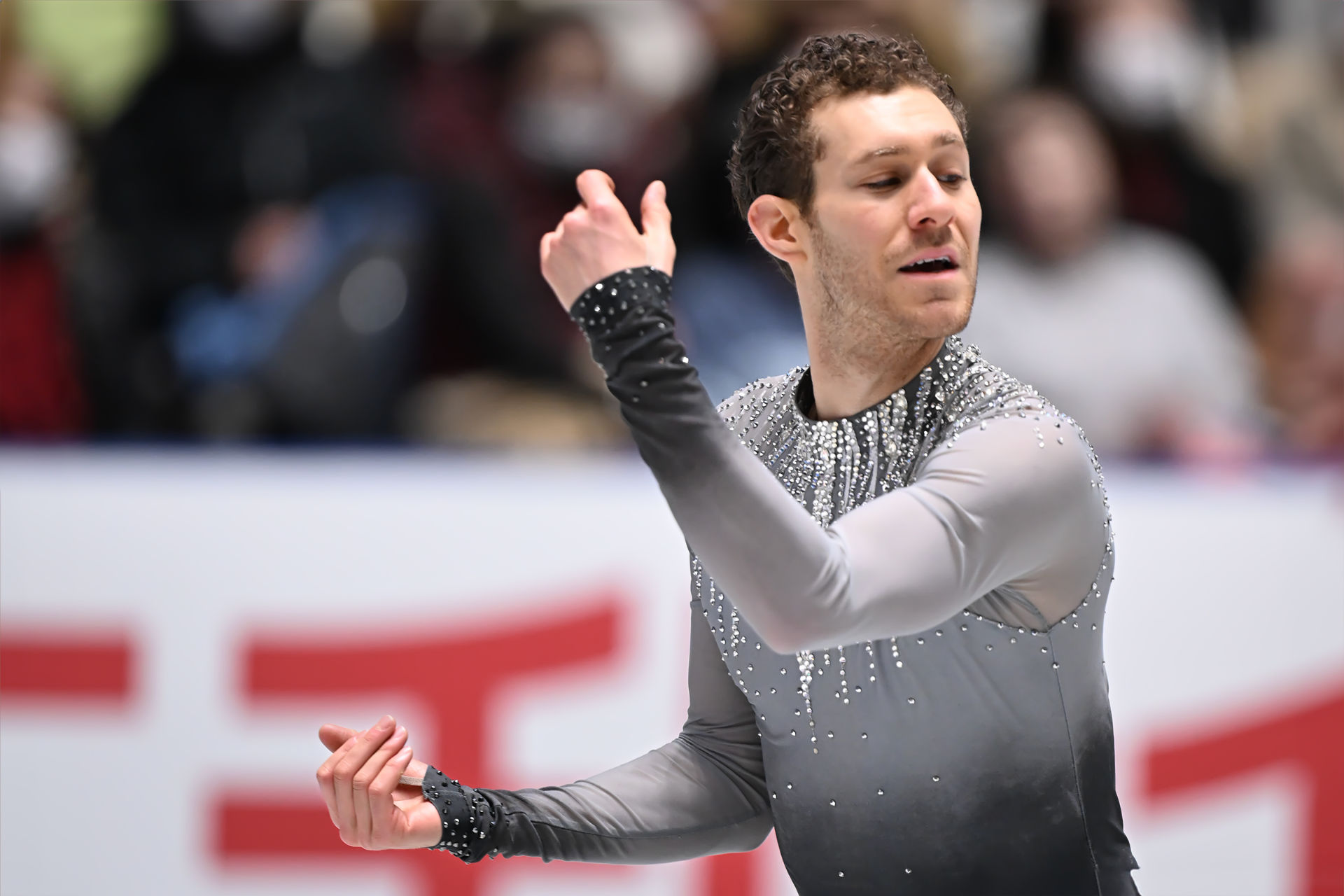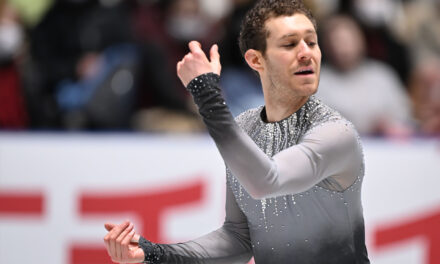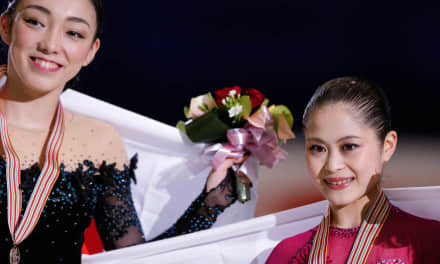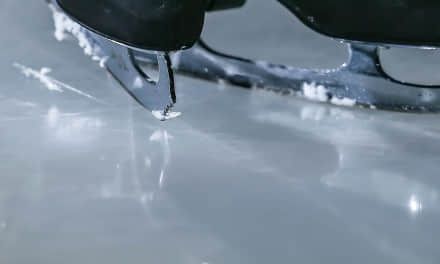
Jason Brown – Painting on the Ice

The NHK Trophy, the fourth event in the annual Grand Prix series, was held from November 8 to 9 at the Yoyogi 1st National Gymnasium in Tokyo. Established in 1995, the ISU Grand Prix of Figure Skating Series consists of six international senior-level competitions, where participants earn points to qualify for the prestigious ISU Grand Prix Final. Skatingchina had the privilege of sitting down for a one-on-one interview with Japan’s crowd favorite Jason Brown, who finished 7th at NHK Trophy, diving deeper into the intricate worlds of his programs.
1.How do you feel one day after taking part in NHK Trophy for the first time in a while?
I'm just so happy to be here. Of course, there are things in the programs this week that I wish I could have done better, but as a whole, I'm just so happy to be back on the Grand Prix circuit and to compete. I learned so much this season, and I can't wait to go back to training.
2. In this interview I would like to talk about your programs and go a little deeper into the details. Your short program is Tarzan (which was a long program before). Why did you decide to make Tarzan into a short program?
Last season, I was only doing a partial season, and I didn't have enough time to compete it, to get comfortable with such new material and to push myself in such a different direction. But there was still something that I loved so much about the program and it felt like an obstacle that I wanted to overcome. I didn't have the time to do it, but I wasn't ready to give it up. I was like, “No, we're going to figure this out!” So my coach and I and the choreographers decided to kind of reinvent it and do it as a short program because I was still really eager for the challenge. There's something so strong and bold about the piece of music – and so dynamic. I just love it! But it's difficult, it's really hard. Hopefully, you'll see and I’ll feel that it gets more and more confident as the season goes on. Knowing that the next season being the Olympic season, we wanted to do something that I felt very confident with, and styles of programs that were in my wheelhouse that I could just sell at. So this year, we really wanted to take the risk and try something different.

Photo by SkatingChina
3.How about the difficulties of making a former free program into a short program?
My coaches and I tried to reinvent it. We tried to reinvent the storyline, we got a new costume, we changed the themes, we changed the patterning and a lot of the choreography… That was intentional, to get out of my head of what it was as a free and create something new as a short. With the same music – but changing the meaning, the composition of it. The transition was – I wouldn't say easy, but I was more familiar with the piece of music, so I kind of knew the ins and outs of the intricacies of it. That said, it has been a little bit of an adjustment to completely change the meaning of the program and rework patterns and styles.
4.You just touched on working out a different story and a different meaning. What storyline do you have now? And what meaning do you want to convey?
When we first crafted it as a free skate, I was really trying to portray the character. This time, when we created it into a short, it was kind of more grounded. The mentality was getting a little bit away from the character of it and more into the nature, the groundedness, the dynamics of the elements… More like fire, water, earth, air – it’s in some ways dealing with the different varieties of nature. Feeling the earth, using the earth. And then, obviously, the dynamics of those different elements kind of showing up.
5.Can you give an example of how you portrayed the elements?
At the beginning, it's more of that airy earth grounded. And then as soon as I do that split jump and the music changes, the second half of the program is where the match is lit and it's like – fire. It's dynamic! You're running through the forest! It's definitely more gritty. Not that I'm being chased, but I'm on the chase. I'm running after something. And so, it's much more like I'm on the attack, that type of feel.
6.It's very different from your free program “Spiegel im Spiegel”. What is the story behind the free program. Yesterday (in the mixed zone) you said that you really worked on connecting all the elements to be united into one.
When I think of this free program, it's almost the way that you have this blank canvas and you start to draw, and it's like, “I'm the artist, but I'm also the pen.” As the program goes, there's something so simplistic and relaxing, just calm about the music, and there's that through line of the music throughout the whole thing. It keeps that same rhythm, that same pacing, but at the end of the program, I really want it to almost be a surprise that it ended. It is like, “How did four minutes go by?” It’s like that concept of, if you're watching someone draw and you don't really know what they're drawing, but they keep going. And then, suddenly a picture appears at the end and you're just like, “Whoa!” That whole time, it was like creating this piece.
And I think another interesting dynamic of these two programs is: In the short program, I want people to have that mentality where you lean in because you're like, “Oh, my God, what's going to happen? It's so intense!” And in this free program, I want people to sit back and relax and just enjoy the beauty of the sport and just watch the canvas or the painting being made. And then, when I hit that final pose, you see the full picture.
7.You said you are drawing a picture on the canvas. What does this picture look like?
I like the idea of leaving it up for interpretation. And I do love, obviously, playing along with the title of the song “Mirror” and seeing your reflection. So, what do you want to see? I’m painting this picture, but at the end of the day, it's how people talk about the beauties and the eye of the beholder. What do they make of it? What's their interpretation? How do they feel after the performance? It’s really “your idea of what the picture is, is so different than my variation of the picture” versus someone else's, and I think it all depends on your perspective and where you are.

Photo by SkatingChina
8.The next question might be a little bit difficult, but when I watch you skating, you always seem to really feel the music, you are immersing yourself into that world. How do your programs look through your eyes when you are skating?
It changes as the season goes on, and as I get more and more comfortable with the pieces of music. At the beginning of the season, my head's more on counting the spins, making sure I'm holding them as long as they need to be, setting my jumps up properly because it's new and so my focus is a little bit more on the layout. But then as the season goes on, I am able to create my own world when I'm out there. And included in my world is the audience as well. They're part of that bubble. And it becomes more of a continuous through lining versus it being like, “One jump. One jump. One jump”. But what I try to do is that one of the things I always, always try to do: No matter if there's mistakes or misses, I really don't want it to impact the performance, and I don't want to break the character in those times, so it's like, “Get back up and you keep going.” When it all works and it all is smooth and beautiful, you're all in that feeling, you're in that emotion. Competition is hard. Things are difficult, so I definitely am thinking as well about the elements that I need to get done.
9.How would you say, does your own personality reflect in both of the programs?
In the off season, I also choreographed potential programs for next season. And those are very personal and relate to experiences that I've gone through. So for this year, I guess it was more about making them about feelings. When we talk about the short program, it’s the feelings of the elements, the feeling of the intensity and playing with the fast and slow and the pace of it all. And then the free program is about continuity. So less about the personal story with these programs and more about the goals of what we wanted to achieve in terms of the skill set of what I wanted to work on. Working on that fluidity, working on that continuity, working on the edge work, the lines. And then, in the short, working on the dynamic, working on the pace, working on the intensity.

Photo by SkatingChina
10.Yesterday you said that your new long costume is still in the process of being worked on and that you therefore performed with your old short program costume. Can you give us a glimpse of your new costume?
We kept the short program costume that I used in the past, two years ago, when I competed with “Melancholy”, but we're working on a new costume for the long (program). We were trying to go in a little bit more of a flow. The most costumes that I've worn recently are very tight fitted – usually a turtleneck. I really like that look on me, I think it shows off my lines. But we were trying to do something a little bit more subtle, have a little bit more flow to it. It's still simplistic, but very, very beautiful. However, when you do something that isn't as tight fitted – it’s kind of funny to say – but you really want to get the fit, because you want it to sit right. And it was just kind of too bunchy and it didn't fall on my body. Where the flow was wasn't where we wanted the flow to be.
11.As you already mentioned, it’s the Olympic preseason, so I think many skaters are experimenting. How about you? Did you experiment with your program? What did you try out?
Both of these programs are very difficult in terms of the styles that we're going for. You have the short program: It's very dynamic, very powerful, a different kind of style than I've done in the past. And this free program, while I skated to piano pieces before, the simplicity and the stillness and that through line are so hard. And it's not very forgiving. There's not like you can hide under the beat of the music. Everything is exposed, so it's very vulnerable. Those were really the challenges that we wanted to tackle in this year because, as you mentioned, with the Olympic season, we wanted to do something that I was very confident with. And so this year, too, we were also trying and creating some different patterns, some different spins, to see, “Okay, we like this one. Okay, we don't like that one. Okay, how can we integrate this into next year's programs? Okay, maybe not bad, but give it a go and test them out”. And that was a huge, huge reason why I even did the Grand Prix series this year where I hadn't done it in the past. We wanted to get out there, figure all these things out so that I was best equipped and ready to tackle next season.
12. You did lot of shows last summer, also in Japan. What did you take away from them?
When we are in the competition season, we might perform our program seven times throughout the year – if we get really lucky and get multiple competitions, two Grand Prix or a Senior B in the fall, and then Nationals, maybe a Four Continents, Worlds… Seven is a lot. In a show, I might be doing seven shows in one weekend. And so the fact that you just get to keep cutting it back out on the ice over and over and over again, and having the ability to deal with very different factors… Getting your skates on quick or “Okay, now, I'm jumping” or “Okay, now I have a five minute break, and I need to get back on the ice”, and you're dealing with different ice surfaces, the size of the rinks are different, and dealing with professional athletes. You're not trying to be perfect in this perfect box, you have to be adaptable. You're playing with the audience. Every night is a different audience, a different crowd, a different venue, different rinks, different sizes, so you're always adapting. When I did get to compete at the end of the year, it felt almost more like a show where I was like, “Oh, I know how to adapt. Oh, I know how to have the mileage with the programs”. I was able to perform them more in shows and work on the consistency of things and get a good feel for it.
So, what was really good about not doing those this year was that I had time to address issues that I may not have had the opportunity to do when you're constantly “Go go go go go!”. But working on new material – it feels right now that I'm at that starting point, where in the last couple of years with doing those shows, I felt like I got to work out the material so many times prior to the time I competed with it. Now I’m like, “Oh, my God, it's so new!” I'm still in that figuring out phase.
13.So also now, do you still feel like being at a show when you’re in competitions?
I'm always going to have that competitive side in me. I always want to do the very best I can, I always want to fight till the end. When I go out and compete, there is that side that's always present, and then there's that other side. I just want to give the audience a performance that they'll remember and that they'll love. And I'm just so grateful to have the chance to be competing and doing what I love. To share that with the crowd is really special.
(Written by Mitsuoka Maria-Laura, photographer: Hsinyi Ho)
















近期评论
——“花样滑冰是艺术与体育最好的结合”
——“花样滑冰是艺术与体育最好的结合”